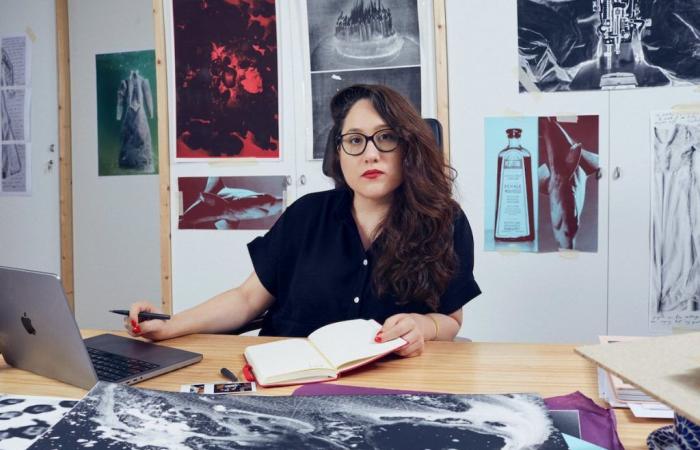The latest winner of the National Photography Prize is a relative unknown in Spain, where her work and her research on eating disorders or gender equality have barely been exhibited in public or private places. Outside the country, the three series of his project A History of Misogyny (A History of Misogyny) have visited fifteen countries. We are referring to Laia Abril (Barcelona, 1986), who in 2023 became the youngest person to receive this distinction from the Ministry of Culture.
He also won the PHotoEspaña revelation award in 2016, obtained a scholarship from the influential Magnum Foundation in 2019 and, that same year, was a finalist for the award sponsored by the Deutsche Börse Photography Foundation. “The other day I spoke with Cristina García Rodero, when she was awarded the Ortega y Gasset Prize, and she was very angry. She told me: ‘Don’t they do an exhibition or a catalog anymore when they give you the National Award? Well you have to say it.’ And I say it, although I had no idea that it did happen before,” she explains via video call from her studio in the Barcelona neighborhood of Sant Andreu.
April studied journalism and advertising at the Ramon Llull University. “Many think that, since I do research, I use journalism as a basis; However, that is not the case,” says the artist, who uses portraits, but also texts, installations, videos and various objects, which lead to devastating visual essays. After moving to New York to study at the International Center of Photography, in 2009 she moved to Treviso, to work as a researcher and editor at Colors, the magazine of the Benetton group that closed in 2014. “The image has been very much in conflict with the text: either you take photos, or you write. And I didn’t see the point in that monotheism,” he adds.
This is how his project on eating disorders emerged, after which he embarked on his misogyny trilogy in 2015. “At first I tried to sell these kinds of topics to the media, but they were very difficult to place,” he recalls. “They told me: ‘Well, that happened before.’ Or: ‘That happens in other places.’ So I created a kind of comparison between different countries and times to show that this does not belong to the past.”
Each of the three series about misogyny arises from a trigger. The first was the reduction of the right to abortion that the PP Government enacted in 2013, promoted by Alberto Ruiz-Gallardón. “For me that was a “shock”, he assures. This is how it was born On Abortion (“On abortion”), the opening chapter. Although she had always worked in photobook format, in 2015 Sam Stourdzé, the director of the Rencontres d’Arles photography festival, proposed an exhibition to her. “It is very rare that the most important photography festival offers you something like this. And much more because I was not even 30 years old and came from a different background. I think that was when I made the leap into the world of art.” That exhibition is still touring internationally and arrived in Paris a few months ago.
“With On Abortion I realized the repercussions of their lack of access: the woman is forced to be a mother, she ends up in prison or dies,” she laments. “I have a deja vu horrible because, when I finished that series, Trump was about to become president in the United States. And now he has every indication that it is going to happen again. The United States has gone to shit in an astonishing way. “It was seen coming, but it has reached a point where many women are dying there because they cannot legally terminate their pregnancies.” One of the stories that impacted him the most was that of the extreme right groups that are dedicated to planting bombs in American abortion clinics. “And they call themselves pro-life. It’s one of the craziest things I’ve ever come across. Pro-life terrorism! The name is fascinating.”
In 2016, the La Manada case took place, the trigger that gave rise to its second chapter, On Rape (About rape). “I felt like we were no longer affected by group aggression, because it didn’t even surprise us anymore,” she proclaims. “What hurt us was the failure of society and the judicial system. That’s why I decided to put the focus on the institutions, which have generated a rape culture that works perfectly.”
On Rape, which premiered in 2020, has just passed through C/O Berlin, one of the photographic foundations of the German capital. One of the pieces that causes the most perplexity in the final section of the montage is Custer’s Revenge, a 1982 adult video game created for the Atari console, inspired by the figure of the American general George Armstrong Custer. There, the user’s ultimate goal is to rape a woman who has been captured and tied to a post. “To make matters worse, she is a Native American,” Abril warns. “She has it all: misogyny, racism… Although the mixture of video games and rape is something that is seen in many other cases.”
Laia Abril now resides between Barcelona and Switzerland, where she is a professor at the University of Design, Film and Art in Lucerne. She has now finished On Mass Hysteria (On collective hysteria), the last part of his trilogy, which has already been seen in that country. In Spain, once again, we will have to wait. Apart from the Barcelona foundation Foto Colectania, which hosted On Abortion in 2019, and Arco, which this year showed a small fragment of On Rape, His project about misogyny has practically not been exhibited in Spain.
“In this country there is a double problem,” he says. “On the one hand: who is behind the private art foundations, what kind of people put money there and what are their political affiliations? On the other hand, in the public sphere, most of the institutions with the capacity to bring exhibitions like this are in Madrid. And they depend on the Community of Madrid.” And smile. “Well, that’s it. I do not have much to add”. And the smile turns into laughter. “I have managed to carry On Abortion to Dublin, during the referendum on the voluntary interruption of pregnancy in a country like Ireland, Catholic to the hilt and where women were persecuted for this. But in Spain it seems there is no way. I find it curious.” Laugh to avoid crying, yes.





